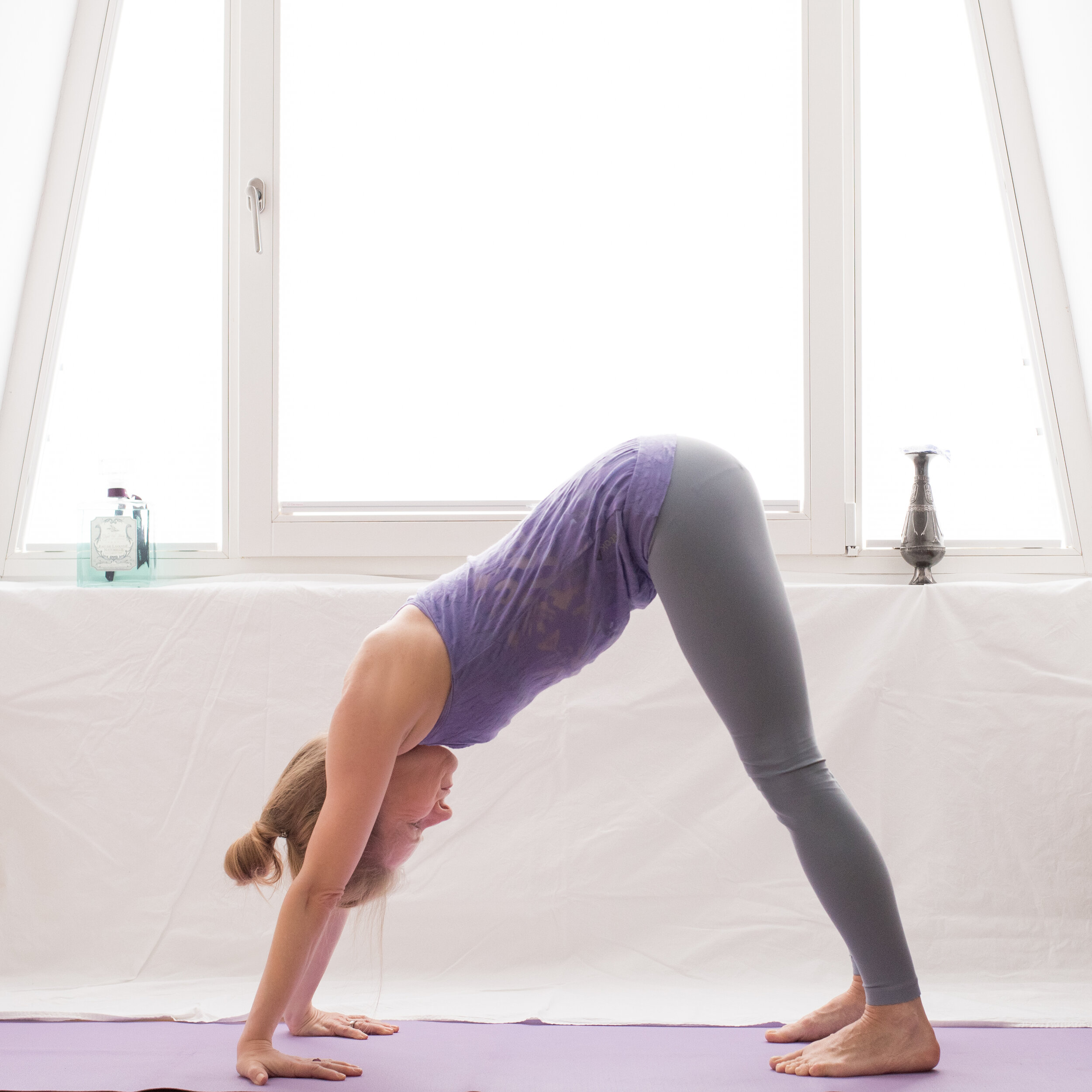Integrating exercises
It’s not realistic to plan a second practice during 24 hours with additional exercises. One intensive practice per day usually is enough. If there is time for more it’s great, often so many other activities need to be done. So I try to integrate exercises in my morning practice that support asanas I’d like to learn.
Examples are the hands. They need to be strong for many asanas:
Whenever the hands are on the floor it’s good advice to press them firmly against the floor. The fingers support this grip. It’s not that the hands are put nicely on the floor. They must hold the body in all the inversions. The poses become easier when the fundament is firm.
When I realised that I have to put strength into my hands I could suddenly perform mayurasana.
Yet also the vinyasa (jumping forward and backward) require a strong foundation. When the hands become like claws it’s easier to hold the body.
After utkatasana I practice bakasana (see picture). For me bakasana is not only a transition asana, I hold it much longer to get stronger hands. This pose forces to have a firm grip, otherwise the asanas is not possible or one might fall forward. The hands keep the body off from falling forward.
Strong hands are required when working on back bending. How shall my hands be able to crawl to the feet, when they are week. It’s not possible.
These tiny exercises can make a difference. It’s possible to integrate them into every practice.
Also today I practiced 90 minutes. I had a phone call at 9 am, that’s why I had to get up early. On time I was ready for the day and the duties that are part of every live. I forgot to practice urdhva dhanurasana. I don’t care that much. Till the end of August I’ll focus on one goal. It’s to practice more frequently. More frequently is rather spongily. I aim for 6 times a week. When I exceed my average frequency by 20 % I shall be happy. I can set fresh goals after August.I appreciate every day when I practice. Having a regular training is the foundation for every learning. This might sound tribe. Yet the gap between wanting and doing is often huge.
Tomorrow will be the 4th practice in a row. To practice is the goal. No additional mini goals or sub goals are planned. Focus is power. No matter how intensive the practice will be, it’s another step in the direction I want to go.
Embrace discomfort
Bakasana, Nov 2020
Since more than a decade I tried to eliminate all possible discomfort. I realize that it’s not possible. Discomfort comes, discomfort goes. Then something else arises at the horizon that isn’t pleasant.
I remember my pranayama teacher from India. He told me that he showers cold every day, even though warm water is available. He prepared himself for the times when warm water was not available.
We can learn to live with discomfort. Then it becomes easier to bear. An example: When I feel the stretching I focus also on the breath. I keep breathing evenly. This helps to relax despite the stretching discomfort.
Simply observing what happens is another method. With time we can learn to distinguish different sensations in the body. We might get closer and closer to our limits.
Discomfort helps us to learn and to grow:
A cold shower in the morning strengthens the immune system.
Taking the steps instead of the elevator is good for the heart.
Preparing meals is time-consuming, but healthier as the meals in restaurants.
The more often we face a difficult situation the easier it becomes to handle this situation.
Today I wanted to omit bakasana with straight arms. I’m not able to do it, I thought. But I tried it. It was not easy to move forward. I did it. When I saw the picture I loved it. Never before my arms were stretched like in the picture. This gives me self-confidence.
My lesson for today: Don’t avoid discomfort. Start easy. With time it becomes more and more satisfying to go through difficult situations. That’s how we learn.
Sitting on the sofa all day long is not really inspiring.
Keep practicing. Stay open for surprises.
Bakasana
One of the counter poses of the back bending asana is bakasana. It’s exercised after all these demanding back bending asanas of the second Ashtanga Yoga series. Sometimes I do first baby pose before practicing bakasana. It’s more relaxing. I usually don’t omit bakasana. It’s a balancing pose. Strength is required. The goal is to stretch the arms. I think they are already more stretched than ever. It’s important to engage the pelvis floor and the abdomen to create a light body. This pose improved because I stretched the wrists. Reverse dog is part of the gravity training. It’s an intensive stretch, but doable. The fingers point to the toes and not forward. When stretching the arms the body moves forward in order to balance. Strong and flexible wrists must allow this movement. It’s possible to exercise the wrists separately I reverse dog for instance.
Bakasana is often a transition asana. Progress doesn’t come overnight.
Keep practicing.





